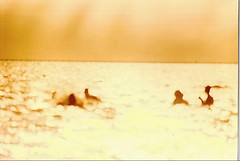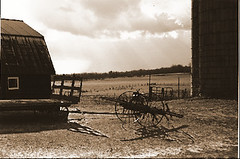Things Happen: Reversals of Fortune in Ford's Stagecoach (1939) & Sirk's All That Heaven Allows (1956)
Since classic Hollywood cinema by Bordwellian definition deals in reversals of fortune ad nauseum, this treatise will examine the specific vehicles of catharsis employed in these next two films. Ford's titular object and Sirk's small 1950s town provide, respectively, compression and the ultimate denouement necessary to off-set its characters' accomplishments, each doing so in a unique way. Where the literal stagecoach brings together a rag-tag ensemble through proximity, the more conceptual town actually eats at the sense of space between two people until it seems like there's simply no room for a relationship. The difference between the uses of mise-en-scene in these films, beyond the obvious adjustment for makeup and costume in black and white, speaks to a meaning deeper than the surface stories. The lighting and setting especially contribute to the psychological parameters of the characters' relationship to each other and to their setting, the cohesive and centrifugal forces of these plots.
Ford was making a Western. A train could have been the natural option of vehicles, but it would have ousted the potential threat of attacking Apaches and allowed its passengers too much leg room. The stagecoach instead redirects the eye to its passengers rather than the setting. The long shot of it moving through the desert establishes and re-establishes the wild surrounding it, both letting the audience know that the gang is on the move and reminding it of what a small capsule careens through this unknown country. Inside, though, space is constructed in such a way to study each character. Since the relationships between certain characters change substantially by the end of Ford's film, special notice should be given to the placement of those characters within the narrative, lighting and the costuming that offers more than standard, Western denotative functions.
Social position feeds the main conflict and resolution of Stagecoach. Although the natives present the variable of a potentially hostile threat, they remain as such; it is the people whose lives intersect on the journey who threaten the peace more intimately. While inside of the vehicle, the shots are largely formal, medium compositions that dance between straight shots and more angled ones. Part of the justification for this lies in keeping the conversation participants and their respective seats in the coach straight, to witness who is looking and speaking to whom and who is avoiding eye contact and discussion. John Wayne, as the black sheep of the pack, sits in the odd seat on the coach's floor, allowing for nearly 360 degrees of camera movement which the cinematographer uses to compress the air between the stuffier inhabitants when appropriate. It also allows for a variety of exterior events to be visible through the coach windows. Partly in keeping with the development of the characters, but also to aid the impact of the eventual surprise of the Indian attack, the camera only leaves the coach interior when the action justifies it wholesale.
The director makes good use of the film's mise-en-scene at the intermittent stops outside of the coach, too. If the coach is his characters' catalyst, the breathers between act as air sacs for expansion upon the theme of social justice. The scene which exposes the society woman to be pregnant provides ample goodies that demonstrate the changes occurring in the group in subtle ways. After she faints at the news of her husband's wounding, the rest of the gang rushes in to see her, and for that brief moment, they are all the closest together that they will ever be. The lighting of that scene has the advantage of existing in one of the larger interior sets used, and it interplays with the suspense not only in terms of shadows against a wall but also in terms of significant costuming highlights.
While much of the costuming in Stagecoach is denotative of societal rank (as with the banker, who wears decidedly authoritative black dress) or ancestral background (like the doctor who wears an Irish-style derby to set off his accent) Ford also personalizes each actor's garb. By doing so, he opens up the floodgates of symbolism through clothing. The gambler, for instance, wears a spotlessly white hat that glows in a spike of light during the suspenseful delivery scene; yet, doubts had been raised during his introduction regarding his status as a gentleman. Whether the glow is meant to be sinister or not, it is intriguing because his character has so many shades of nuance -- and in a way, that is reflected in the hat. An even greater development exists between the society woman and the more coquettish one that we can assume to be either a dancer or a woman of looser morals.
The society woman rejects every offer of help from the woman, often in the form of an item of clothing that would wam her. By the film's end, the new mother not only uses the clothing but accepts it as a gift. In this way, Ford allows the personalization of costuming to permeate the cathartic bonds that the stagecoach helps to create.
Sirk's town in All That Heaven Allows sets the pace of the film from the opening scene of a church's bell house, upon which the clock hands read as noon. The town, like the time, is already in full swing; at least, as much as any sleepy, little American town can be. Yet the town will also share another characterisitic with time: both are products of human invention and, as such, are transient. To support the themes of self-reliance and independence introduced in the film, time is used as a suggestion, perhaps, that its illusory power has as little true consequence as the town that is the psychological obstacle to Rock Hudson and Jane Wyman's romance. Many of the motifs in the film likewise support the natural world of American transcendentalism, but Sirk does not limit the mise-en-scene to the typical perception of all things New England.
The spacing of the characters, like the objects in the setting, is airy and uncluttered. Very little physically separates the actors in Sirk's melodrama besides light and dark. Characters are alternately alone and close together, as they need to be, as if to suggest that all is well and to reinforce the naturalness of independent thought through independent action. In her own home, the film never once shows the mother in her kitchen surrounded by gadgets; it is the children who bring some small sense of clutter to the film, when the son mixes drinks or when the daughter plays with her mother's makeup. Sirk even goes so far as to create a sense of cacaphony visually speaking during the party, by placing people chaotically throughout the frames on the evening that ends in social disaster. Meanwhile, on the hipper side of town, Rock Hudson's friends present a more ordered universe as they sit to eat at a long table that, although arranged at a 45 degree angle to the room's walls (denoting, perhaps, their differences with society), has seats in a uniform pattern for people to dine together charitably.
After the more chaotic party, Sirk reveals the clock again, in the full darkness of midnight. The temporal reality foreshadowed at the film's opening now takes on a deeper meaning and the interior lighting follows suit. When there are misunderstandings between Jane Wyman and her children, for example, they exist more in the shadows of the frame than in the lighted parts. It is interesting to note that that particular phenomenon of people conversing in shadows takes place only in the house that once belonged to her and her now-dead husband. By such extension, his ghost reaches into her life as effectively as the town reaches into the main relationship. Vibrant colors and patterns of light -- especially upstairs in the more familiar, personal rooms -- further emphasizes the haunted feeling without resorting to pointing to it through dialogue or special effects.
The absolute vibrancy of such shots acts as a relief from the story's progress, even if the diversion is one from romantic conflict to mother-daughter tension. Opening up the characters' relationships, these lighting choices add a whole, new dimension to the film that may have been more flat had it not begged the audience's attention to the strangeness of these people's lives. A woman in emotional solitary confinement, a daughter who feels like she knows better than her mother and an overprotective, fickle son would have played much differently -- as if these were people we had already met and there was no real story here -- without the lighting and color choices.
Character development especially benefits in certain areas. Consider the scene in which the busybody best friend attempts a heart-to-heart with Jane Wyman. The friend realizes that the housekeeper can hear them despite the vacuum cleaner and the action moves from this:
to this:
Although Sirk never spells it out, such actions clearly delineate the understood separation between society people and the working class in small-town America and underscores the social conflict resulting from Wyman seeing her gardener. By contrast, Rock Hudson's friends make no such separation and the audience can realize this by comparing the difference between a catered party that is already in full swing at the busybody's house and the more rustic do-it-yourself shindig that happens across town:
where Wyman discovers Walden:
Perhaps one of the more interesting aspects of All That Heaven Allows is the museum-like quality of much of the setting. Exteriors reveal a very New England-looking autumn, but interiors often appear very serene, with a sense of almost sterile grace. The cold, damp grey of the old mill -- which Wyman prefers to the dowdier yet cozier house Hudson sleeps in -- would be uninviting were it not for the fireplace and the view. Sirk even uses framing to depict a sense of artistic stasis, exampled by this shot in which Wyman looks more like a bust on display than a woman about to go somewhere:
Such images are beautiful and haunting, with an organic quality between them, including a reference to the dead father's trophy on the mantelpiece that appears in a later visual reference on the patio at the party when a neighbor attempts to kiss Jane Wyman. [1] The reference is book-ended by the son's later protests against Rock Hudson marrying into the family, during which he brings up the trophy again, none the wiser that were Wyman to marry a man more acceptable to him and their society friends that she would be reduced to little more than the trophy that she sees reflected in the TV set the children buy her as a consolation to her widowhood. In that moment, the denouement is complete as Wyman realizes the falsity and emptiness of the life that stretches before her if she continues to care what other people think of her.
Although Sirk's approach is more subtle and perhaps craftier than Ford's, each film still exists within the framework afforded it. The distractions that occur within each film serve purposes in conjunction with -- and not contrary to -- the films' best interests. The singing Apache woman may seem at first like a considerable and even jumpy digression from the film's internal movement toward peaceable relations and certainly from its explicit movement toward the end of the coach ride, but it acts as cover for horse thieves to get away, distracting both the audience and the on-screen characters at once through unexpected entertainment. The early, somewhat shocking medium shot/jump cut of the banker warns the audience that something is not right without giving away an important plot point that would have detracted more from the film than the shot does had it been gleaned early.
These considerations promote the pleasure of viewing, the addition of information occurring only when necessary. Perhaps more important, though, to the filmic world is the sense that each film acknowedges that duration is short and fleeting, that the stagecoach ride can only last as long as a town or a memory's hold upon a person. In that sense, each film takes a greater place within the cinematic world, each aware of its own transience and mortality as surely as anyone who ever lived in the Old West; or anyone who has walked the streets of a small town with her thoughts miles away in Walden's Pond; or anyone who has ever noticed how silly and filmic real life can be.
[1] It is impossible for me to determine whether I would have picked this out on my own, so I must give credit where credit is due: former film blogger Andy Horbal first pointed it out in a post complete with screen grabs. Check it out.
Labels: Bordwell and Thompson Series, Film, Ford, Sirk





















1 Comments:
Lol. Thanks, Dr. J.
I am in Dr. L's film class on Mondays...that's how this series originated.
Post a Comment
<< Home